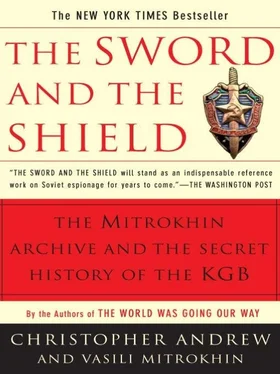On September 19, 1974 Andropov approved a large-scale, “multifaceted plan” (no. 5/9-16091) to discredit and destabilize Solzhenitsyn and his family and cut his links with dissidents in the Soviet Union. A Fifth Department officer with experience of the PAUK case was sent to Switzerland on long-term assignment to direct a series of operations against Solzhenitsyn. 52The KGB sponsored a series of hostile books and articles, among them a memoir published under the name of his first wife, Natalia Reshetovskaya, but probably mainly composed by Service A. In 1975 Řezáč suddenly disappeared from Zurich, taking the manuscript of Prussian Nights with him, and made his way to Moscow to begin work on a biography intended to destroy Solzhenitsyn’s reputation. Shortly afterwards, Solzhenitsyn realized that he had also been betrayed by the Holubs, on whom he had relied ever since he had arrived in Zurich, and broke all contact with them. 53Andropov gave orders to maintain “an atmosphere of distrust and suspicion between PAUK and the people around him” by feeding Solzhenitsyn constant rumors that others in his circle were KGB agents or deceiving him in a variety of ways.
The plan to destabilize Solzhenitsyn also sought “to create a state of nervousness within his family” through a constant stream of threats against his children and the sending of suspicious packages which looked as if they might contain explosives. 54The Sakharovs were subjected to similar treatment. Shortly before Elena Bonner was due to have eye surgery, they were sent photographs of eyes gouged out of their sockets and other horrifying eye injuries. At Christmas 1974 they received dozens of envelopes containing photographs of car accidents, brain surgery and monkeys with electrodes implanted in their brains. 55All such threats, Solzhenitsyn told Time magazine, “come from one and the same organization”—the KGB. 56
What is most striking about the KGB’s campaign against Solzhenitsyn during his Swiss exile is the enormous priority and resources devoted to it. The “plan of agent operational measures” to be implemented during 1975 against Solzhenitsyn and the émigrée journal, Kontinent, with which he was associated, was jointly agreed late in the previous year by Kryuchkov, Grigorenko and Bobkov (heads of the First Chief, Second Chief and Fifth Directorates). It had nineteen sections, of which the first three alone provided for twenty different hostile operations. 57The residencies in Berne, Geneva, Karlshorst, London, Paris, Rome and Stockholm were all involved in implementing the “agent operational measures” and a series of joint operations were planned with other Soviet Bloc intelligence agencies. 58In July 1976 plans for yet more active measures, jointly proposed once again by Kryuchkov, Grigorenko and Bobkov, were approved by Andropov. 59
The destabilization campaign had some success. Swiss newspapers reported that Solzhenitsyn asked for, but did not receive, police protection. KGB harassment in Zurich was probably at least partly responsible for his decision to move to the United States in 1976. 60Since his expulsion from Russia two years earlier, Solzhenitsyn had lost some of the immense moral authority he had formerly possessed as a persecuted dissident. Dismayed by what he saw as Western indifference to the Soviet menace, he took to denouncing, sometimes in apocalyptic tones, the moral failings of a West he did not fully understand. After settling in Vermont, he became a virtual recluse on his fifty-acre estate behind an eight-foot-high chainlink fence topped with barbed wire, as he devoted himself to writing a series of historical novels on Russia in the years leading up to the October Revolution.
Solzhenitsyn’s life as a recluse (with occasional excursions to deliver the 1978 Harvard Commencement Address and other solemn pronouncements on East and West) may well have spared him further KGB penetration of his entourage of the kind that had taken place in Zurich. Previously, on August 23, 1975, Andropov had approved a draft directive (no. 150/S-9195), jointly proposed by the heads of the First Chief and Fifth Directorates, Kryuchkov and Bobkov, establishing as the main priority in operations against émigrés the infiltration of at least one illegal into Solzhenitsyn’s inner circle. When Solzhenitsyn moved to the United States, L. G. Bolbotenko, a Line KR officer in the New York residency, was put in charge of operations against him. Though there were numerous active measures designed to discredit Solzhenitsyn and embroil him with other émigrés, there is no evidence that any illegal succeeded in gaining his confidence. 61
Despite failing to penetrate Solzhenitsyn’s Vermont fastness, the KGB seems to have been broadly satisfied by the later 1970s that the great writer’s reputation in the West had declined dramatically. In the summer of 1978, the FCD and Fifth Directorate jointly arranged the screening of a video of Solzhenitsyn’s Harvard Address to a meeting of leading KGB and Party figures. It was an extraordinary moment in Soviet history. Never before, almost certainly, had such an audience gathered together to hear a lecture by a leading opponent of the Soviet system. 62The Moscow notables watched, probably intently, as Solzhenitsyn gave his Commencement audience in Harvard Yard, while drizzle moistened their academic gowns, an uncompromising “measure of bitter truth.” He denounced those in the West whose silence and inertia had made them “accomplices” in the suffering imposed on those who lived under Communist rule. Corrupted by materialism and selfish individualism, the West had become morally impoverished: “Two hundred or even fifty years ago, it would have seemed quite impossible, in America, that an individual be granted boundless freedom with no purpose, simply for the satisfaction of his whims…” Though many in Harvard Yard were skeptical, and some were probably seething, they dutifully followed tradition and cheered Solzhenitsyn’s address. 63
The KGB screening of the address was followed by commentaries from FCD and Fifth Directorate officers. Though Mitrokhin’s brief notes report only their conclusions, they probably cited the hostile reception accorded to Solzhenitsyn’s “bitter truth” by The New York Times and the Washington Post. The Times leader writer found “Mr. Solzhenitsyn’s world view… far more dangerous than the easy-going spirit which he finds so exasperating,” while the Post denounced his “gross misunderstanding of western society.” The KGB commentators were agreed that Solzhenitsyn had alienated his American listeners by his “reactionary views and intransigent criticism of the US way of life—a fact which could not fail to have a negative effect on his authority in the eyes of the West and his continued use in anti-Soviet propaganda.” The meeting of KGB and Party notables agreed that no active measures were required to counter the Harvard Address. 64Solzhenitsyn, they evidently believed, had discredited himself.
TWENTY
IDEOLOGICAL SUBVERSION
Part 2: The Victory of the Dissidents
On August 1, 1975 the Soviet leadership committed what turned out to be a strategic blunder in its war against the dissidents. As part of the Helsinki Accords on Security and Co-operation in Europe, the United States, Canada and all European states save Albania and Andorra agreed to protect a series of basic human rights. Though Andropov warned against the consequences, a majority of the Politburo shared Gromyko’s confident view that “We are masters in our house”—that the Soviet Union would be free to interpret the human rights provisions of the Helsinki Accord as it saw fit. In fact, as Zbigniew Brzezinski predicted, the accord “put the Soviet Union on the ideological defensive.” 1Henceforth its human rights critics both at home and abroad could justly claim that it was in breach of an international agreement it had freely entered into.
Читать дальше











